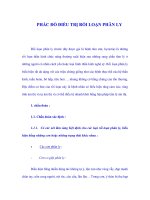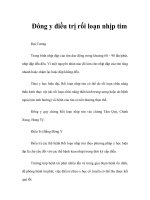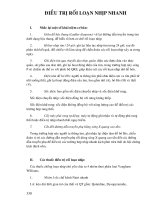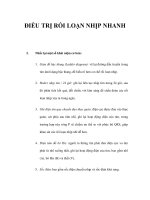Bình luận Thiết bị điều trị rối loạn nhịp nào hứa hẹn nhất trong năm qua
Bạn đang xem bản rút gọn của tài liệu. Xem và tải ngay bản đầy đủ của tài liệu tại đây (1.21 MB, 18 trang )
MULTIPOINT™ PACING
Benefits of Cardiac Resynchronization Therapy
CRT benefits heart failure patients with a wide QRS and
low
LVEF
Compared to RV (right ventricular) only pacing, CRT:
Improves EF, NYHA class and 6 MWT results1
Decreases hospitalizations1,4
Reduces the risk of death2
Compared to optimal pharmacological therapy, CRT:
Reduces rates of all-cause, cardiac, and HF hospitalization3
Quadripolar CRT Systems have represented a new opportunity
to
improve CRT implant success and avoid common CRT complications
such as high thresholds and phrenic nerve stimulation 5
1.
Paparella G, et al. Pacing Clin Electrophysiol. 2010
2.
Cleland JG, et al. N Engl J Med. 2005
3.
Anand IS, et al. Circulation. 2009
4.
Tang AS, et al. N Engl J Med. 2010
5.
Tomassoni G, et al. Heart Rhythm. 2012
SJM-MLP-0416-0052 | Item approved for U.S. use only. | 2
CRT
Challenge:
Non-responders
43%
43% of CRT patients classified as non-responders or negativeresponders by LVESV after 6 months (N = 302)
Ypenburg, C., et al. Journal of the American College of Cardiology 2009
SJM-MLP-0416-0052 | Item approved for U.S. use only. | 3
MultiPoint™ LV Pacing
MultiPoint™ Pacing, exclusively from St. Jude Medical,
delivers two pulses from the Quartet™ LV lead per pacing
cycle, resulting in a more effective
uniform ventricular
contraction
SINGLE SITE
PACING
MULTIPOINT™ PACING
LV1
P4
M3
M2
D1
LV2
SJM-MLP-0416-0052 | Item approved for U.S. use only. | 4
Goals of MultiPoint™ Pacing
Pacing from TWO LV sites is designed
to
capture more tissue to improve:
Pattern of depolarization1
LV2
Potentially improve engagement
of areas around scar tissue2
LV1
Hemodynamics3
Resynchronization4
RV
MultiPoint™ Pacing allows pacing from
1.
Theis C. et al. Journal of Cardiovascular Electrophysiology 2009
2.
Pappone C, et al. Heart Rhythm, 2015
3.
Rinaldi CA, et al. J Interv Card Electrophysiol., 2014
4.
Thibault B, et al. J Card Fail., 2014
two LV sites through just one CRT lead.
SJM-MLP-0416-0052 | Item approved for U.S. use only. | 5
MultiPoint™ Pacing from
a Single
CS Branch
10 CRT-D or 14 CRT-P
VectSelect Quartet™ Vectors
Ability to pace from two LV sites with independent
impulses and programmable delays
Vector
LV1
LV2
Cathode to Anode
1
D1 M2
2
D1 P4
3
D1 RV Coil
4
M2 P4
5
M2 RV Coil
6
M3 M2
7
M3 P4
8
M3 RV Coil
9
P4 M2
10
P4 RV Coil
11
D1 Can
12
M2 Can
13
M3 Can
14
P4 Can
SJM-MLP-0416-0052 | Item approved for U.S. use only. | 6
ACUTE CLINICAL EVIDENCE
International Experience
MultiPoint™ Pacing acute data
Electrical
Mechanical
Methods
Hemodynamic
Single Site
Pacing
This study evaluated the effect of MultiPoint™ Pacing (MPP™) on the left ventricular (LV) activation
pattern and hemodynamics in the same patient population.
A total of 10 patients with non-ischemic cardiomyopathy
underwent an acute pacing protocol that included 2 biventricular (BiV) and up to 9 MPP technology
interventions.
Results
Compared with BiV, MPP technology significantly increased
LV dP/dtmax (30 ±13% vs. 25 ±11%, P = 0.041); reduced
QRS duration (22 ±11% vs. 11 ±11%, P = 0.01) and
MultiPoint
Pacing
decreased total endocardial activation time (25 ±15% vs. 10
± 20%, P= 0.01).
MPP technology also captured significantly greater LV mass during the first 25 ms and first 50s of
pacing, suggesting faster wavefront propagation throughout the LV
MPP technology improved acute hemodynamic parameters,
QRS duration and activation patterns in comparison to BiV.
Menardi, E., et al. Heart Rhythm, 2015
SJM-MLP-0416-0052 | Item approved for U.S. use only. | 8
MultiPoint™ Pacing acute data
Electrical
Mechanical
Hemodynamic
Methods
•
Multi-center, 41 patient study
•
Tissue doppler imaging to assess mechanical dyssynchronny
Results
MultiPoint™ Pacing reduced mechanical dyssynchrony relative to conventional biventricular pacing
Reduced Mean Dyssynchrony with MPP™ feature
80
70
60
50
Ts-SD (ms)
•
40
30
20
10
0
BiV Simul
p < 0.001
Best MPP feature
(of 8 tested)
SJM-MLP-0416-0052 | Item approved for U.S. use only. | 9
Rinaldi, C. A., et al. Journal of Cardiac Failure, 2013
MultiPoint™ Pacing acute data
Electrical
Mechanical
Hemodynamic
Methods
N = 25 consecutive patients implanted with an
MultiPoint™ Pacing capable CRT device
Echo evaluation performed at first follow-up
Results
Reduction in dyssynchrony with
MultiPoint Pacing (AS-to-P wall delay with speckle
Dyssynchrony Evaluation: AS-Post wall
delay (Speckle-Tracking):
tracking radial strain)
Improvement in EF with MultiPoint
Pacing
SJM-MLP-0416-0052 | Item approved for U.S. use only. | 10
Osca, J., et al. Heart Rhythm, 2015
MultiPoint™ Pacing
Electrical
acute data
Mechanical
Methods
Hemodynamic
140
Best
Best MPP™
MPP™ Config
This study evaluated the acute impact of
Best CONV (Quad)
MultiPoint™ Pacing (MPP™) on hemodynamic response in CRT-D patients (n =
44).
RV Only
105
Results
The best MPP technology intervention significantly
and ejection fraction as compared to the best conventional pacing intervention.
ƒThe best MPP technology intervention improved
acute diastolic function, significantly decreasing - dP/dt (min), relaxation time
constant, and end- diastolic pressure as compared to the best conventional
intervention
LV Pressure (mmHg)
increased the rate of pressure change (dP/dt [max]), stroke work, stroke volume,
70
35
Results showed that CRT with MPP technology can
significantly improve acute LV hemodynamic parameters compared to
conventional pacing.
0
150
175
200
225
LV Volume (mL)
Pappone, C., et al. Heart Rhythm, 2014
SJM-MLP-0416-0052 | Item approved for U.S. use only. | 11
250
CHRONIC CLINICAL EVIDENCE
International Studies
MultiPoint™ Pacing 12-month
follow-up
International
Methods
44 consecutive patients were randomized to receive pressure-volume (PV) loop optimized
MPP™ technology or Conventional CRT (CONV) at a single center in Italy.
The primary endpoint was the change in end systolic volume (ESV) and ejection fraction
(EF) from baseline to 12 months in the MPP technology group vs. the CONV group.
Response to CRT was defined as alive status and ≥
15% decrease in ESV relative to the baseline.
Results
ESV and EF increase relative to baseline were significantly greater with MPP technology
than with CONV (ESV: median –25% vs. median –18%, P =
0.03; EF: median +15% vs. median +5%, P < 0.001).
At 12 months, 76% (16/21) of patients in MPP
technology group were classified as CRT responders
compared with 57% (12/21) in the BiV group.
The CRT response rate in the MPP technology group remained consistent at 76% from 3
month to 12-month follow-up.
PV loop-guided MPP technology resulted in greater LV reverse remodeling and increased LV
function at 12 months compared with similarly optimized
Conventional CRT.
Pappone, C., et al. Heart Rhythm. 2015.
SJM-MLP-0416-0052 | Item approved for U.S. use only. | 13
data
MPP™ Technology 12-Month Follow-Up Study Methods
Improvement
in
the
degree
of
response over
12-months
SJM-MLP-0416-0052 | Item approved for U.S. use only. | 14
Pappone, C., et al. Heart Rhythm. 2015.
Benefits of Switching
from
Conventional
CRT
to
MPP™ Technology
Methods
The aim of this study was to evaluate if patients
receiving conventional CRT (CONV) would receive additional benefit by switching CRT
programming to MPP technology (n = 8)
Patients implanted with a CRT 12 months post implant
had their CRT programming switched to MPP technology after echo and NYHA class
assessment and classified as responders (6/8) or non-responders (2/8) based on echo
comparison to baseline.
Responder was defined as ESV ≥15% relative to
baseline.
Results
The two non-responders to CONV became responde
rs
with MPP technology with reduction in ESV and improvement in EF relative to the 12
month exam
The remaining 6 patients classified as responders to
CONV also experienced additional reduction in ESV
and improvements in EF
The study results suggest that activating MPP
technology may be a potential strategy to convert non- responders to
responders or further improve response in patients already responding to
conventional therapy
.
Pappone, C., et al. European Heart Journal Supplements, 2015
SJM-MLP-0416-0052 | Item approved for U.S. use only. | 15
MultiPoint™ Pacing Registry
Methods
QRS Duration and Echo Changes
N = 436 patient, 73 center Italian registry
148 patients with 6-mo follow-up
67 with MPP™ technology ‘ON’, 81 with MPP
technology ‘OFF’
0
40
-5
30
During implant Capture Thresholds were
-10
measured (CTs) and presence of PNS
Results
-15
10
P < 0.000
MultiPoint™ Pacing was programmable in
97% of patients
20
-20
0
At follow-up QRS was reduced and EF improved with MultiPoint Pacing
% DeltaQRS Biv
% DeltaQRS MPP
EF baseline
relative to conventional BiV
MultiPoint™ Pacing Programmability
CT in both
CT in both Vectors
CT in both
CT in both Vectors
Vectors < 5V
< 5V and Without PNS
Vectors < 3V
< 3V and without PNS
% MultiPoint Pacing
Programmability
98
97
89
89
SJM-MLP-0416-0052 | Item approved for U.S. use only. | 16
Forleo, et al. Europace 2015.
EF Biv
EF MPP
Multiple
quadripolar
lead
options
to the right target
vein
to deliver
MultiPoint™
Pacing
Quartet™ 1458Q
S-curve
20-30-47 mm
Original
SJM Advanced
Quadripolar
Quartet ™ 1456Q
Solutions
Quartet ™ 1458QL
S-curve
Small S-curve
20-47-60 mm
20-30-40 mm
Quadra Assura™ MP C
Quadra Allure MP™ RF CRT-P
RT-D
SJM-MLP-0416-0052 | Item approved for U.S. use only. | 17
Multipoint™ Pacing
U.S. IDE study demonstrated safety and efficacy of MultiPoint Pacing
Primary endpoint: Safety and efficacy
Response defined by composite score of Hospitalization, LVEF,
MultiPoint™ Pacing compared
to
the single
mortality
site
pacing
through
Quadra Assura™ CRT-D
Quadra Assura MP™
Quadra Allure MP™ RF
SJM-MLP-0416-0052 | Item approved for U.S. use only. | 18









